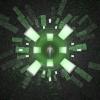Landscape erosion and similar is usually modelled by using height maps. Only once the calculations are finished would this be converted into polygons for eventual display. I don't know how well it would adapt to tectonic plate simulation. I suppose that if each sample on a height map had an x/y position that could be moved laterally, you can view that as a point cloud. But if you join them up, then you just have a standard polygonal system too. It's all just a bunch of 3D positions, just different ways of presenting them.
I have used that, more or less, up until now. But height maps will not do anymore, I need a "density map", i.e. a map that is fully functional in all three directions, so that, for example, a near-vertical wall can be hollowed out. Height maps only do 2D, at least the way I know them. And as a second act, it cannot be dependent on a flat landscape, as I am dealing with full, spherical planets, and possibly other-shaped objects later on. On the face of it, point clouds seem to be able to operate with little to no regard for what direction things point (pun unintended) in, allowing near or full spherical use, and they are not dependent on any fixed surface, since that is generated -from- the density map. I have no idea if what I write even makes sense right now...





